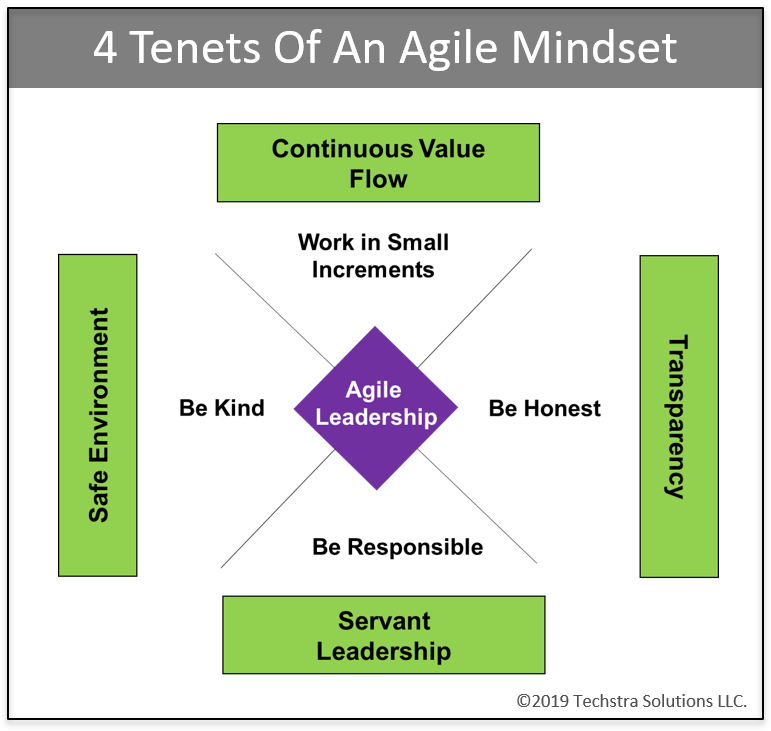Agile Is Easy, Until People Get Involved
By Jay Anderson and Russ White
People are a company’s most valuable asset and the most unpredictable one. Study after study reinforces that human nature seeks stability and familiarity. It shouldn’t be surprising that people resist when they are required to change…and changing continuously at a fast pace only makes things harder! As businesses face constant disruption, leaders have to navigate an often-reluctant team to a place where it can thrive in a constantly shifting environment. While Agile has created a playbook to guide practices in customer-centric, team-based approaches, rapid iteration, and on-going learning, the challenge remains to acclimate people to this new way of working. To maximize the value of Agile, business leaders must first cultivate an environment built on trust that makes people comfortable with and invested in the approach. So how is it done?

Many businesses have tried—and failed—to instill an Agile mindset and create a conducive environment to support its implementation. Too often, they focus on tactics or mechanical processes in hopes of inspiring transformation, and they overlook the cultural overhaul required for Agile to take hold. This is where the hard work resides.
Agile seems easy until people get involved.
In order to sow the seeds for Agile success, a leader must fully embrace and embody the four “mindset” quadrants below. Let’s explore them further.
Be Honest
Here, honesty is defined as more than non-fraudulent; it also comprises of truth and integrity. For example: an honest man (without deception) would tell you he wronged you (truth – he did it, so he knows it to be fact), although there wasn’t a remote chance you’d find out (integrity – it’s the right thing to do).
Failing to embrace the nuanced differences and relationships between these terms is utterly counterproductive in an Agile environment. Organizations and their leaders can’t realize the maximum transformative power of these behaviors when employees are allowed to act honestly, but without truthfulness and integrity. The all-important outcome – trust – will not be achieved. Transformation to Agile requires team members to trust one another. How else can they have meaningful conversations about the causes of below-expectation performance or participate in the robust dialogue required for arriving at the best customer-focused solutions?
And, within the Agile context, these types of meaningful conversations enable transparency. Transparency is about telling people that you have a problem, sharing your feelings about the situation, and providing ways to improve it. Only teams built on trust will be able to have meaningful discussions on these tough topics.
Members of an Agile team need to be honest with themselves and with their leaders. A transparent and trusting environment is one where team members are not afraid to expose issues and recognize that most things can be fixed if they are known.
The key to success is to never be deceptive, fraudulent, or passive-aggressive. Always search for the truth and “be real” when you report on that truth. Remember, failure is an option. It is always an option. In fact, it is required before anything can be learned. Get used to failure, get used to letting people know that failure has happened, cherish what has been learned in the process, and make sure not to impact the customer in a negative way.
Be Kind
In a highly collaborative Agile world, kindness is about showing respect in every interaction, with every teammate. In order to demonstrate kindness and develop the servant leadership style critical to an Agile environment, leaders’ character must embody the following virtues:
- Prudence to make the right decisions.
- Courage to stay the course and resist all kinds of pressure.
- Self-control to subordinate passions to the spirit and fulfillment of the mission at hand.
- Justice to give every individual his or her due.
- Magnanimity to strive for great things, to challenge yourself and others.
- Humility to overcome selfishness and serve others habitually.
These qualities, as stated by Alexandre Havard in his Virtuous Leadership system, are hard to develop. It, therefore, behooves organizations to add these character strengths into selection criteria for new and transitioning leaders.
A framework for interactions can also help teams succeed and afford opportunities to demonstrate respect. Leaders need to operate in a servant style. That means providing vision and then responding to the needs of teams. Both leaders and teams need to have the courage to share thoughts, feelings, and the rationale behind them. They need to be humble enough to ask for help and encourage others to be involved in the situation. As a servant leader, the priority is to spend more time listening and responding with support—without removing responsibility in the given situation.
Be Responsible
Human beings can choose to act responsibly…or they can become victims of their environment. Being a victim entails waiting and hoping for someone else to do something. An Agile leader should never resort to this lack-of-action plan. They need to own problems, find solutions, and put them into place so that their team has a better chance of delivering results. Once leaders decide what should be done, they have to follow through. Yes, you’ve heard of “walking the talk,” but this is more about character and building trust as a leader. If leaders fall down on the trust job, then they must admit fault. This is the other side of the “trust” conversation. Leaders must allow their teams to see that they make mistakes and have failures just like everybody else.
Equally important, leaders need to promote accountability among peers. Peer-to-peer accountability is an essential component of an Agile environment. An “accountable” environment starts with the leader being responsible, fixing problems, and not blaming others for failure. Leading from a position of “I’m responsible,” makes for a safe environment where teams can thrive. Everyone knows and agrees that failure is the first step in learning. The most important information is the WHY of failure; the WHO is only needed to discover the truth about the WHY.
Work in Small Increments
It seems intuitive that it is easier to deliver smaller items in the short term, than bigger ones over a longer time period. Think of it this way: if someone asked you for your grocery list for the third week in May three years from now, it is doubtful you would have anything more than a vague idea. On the other hand, you probably could rattle off a relatively complete list for the coming weekend. The same goes for work in the business world. It is easier to estimate and conceive what can be done in the next week than predict a product delivery months or years into the future. While long-term goals can be approximated, short-term ones are usually much more accurate.
Aside from the accuracy and predictability of outputs, working in smaller increments allows teams to react to changes in the business environment. If the world pivots and a team has done two weeks’ worth of work, then that is all that is lost. If, however, a team is nine months into an 18-month development cycle and a shift occurs, a business stands to lose much more.
In an Agile environment, the focus must be on constantly seeking customer feedback and completing items that represent value to them. Consistent, predictable delivery of value is what builds customer trust. The ability to work in small increments is what allows for this constant predictability. Increments can be up to four weeks in duration (and are usually longest early on to allow teams to familiarize themselves with the new environment). Shortening the increment to two weeks, as the teams become comfortable, enables a more rapid flow of feedback and value delivery.
Institutionalizing the Four Tenets of an Agile Mindset
Operationalizing the four tenets of Agile—being honest, kind, and responsible, and working in small increments—increases the speed at which clients get meaningful value. However, the experienced Agile leader also realizes that building and sustaining this culture provides benefits far more valuable to his or her organization than simply quickly getting work done. This culture creates a respectful and engaging environment where people want to work. Ultimately reducing costs associated with employee dissatisfaction.
Implementing a flourishing Agile culture is not a task for the faint-of-heart. This will require a true servant leader—an individual with courage to provide a vision, confidence to respond to the needs of employees, and the unwavering support of his or her organization. You can be this leader.
